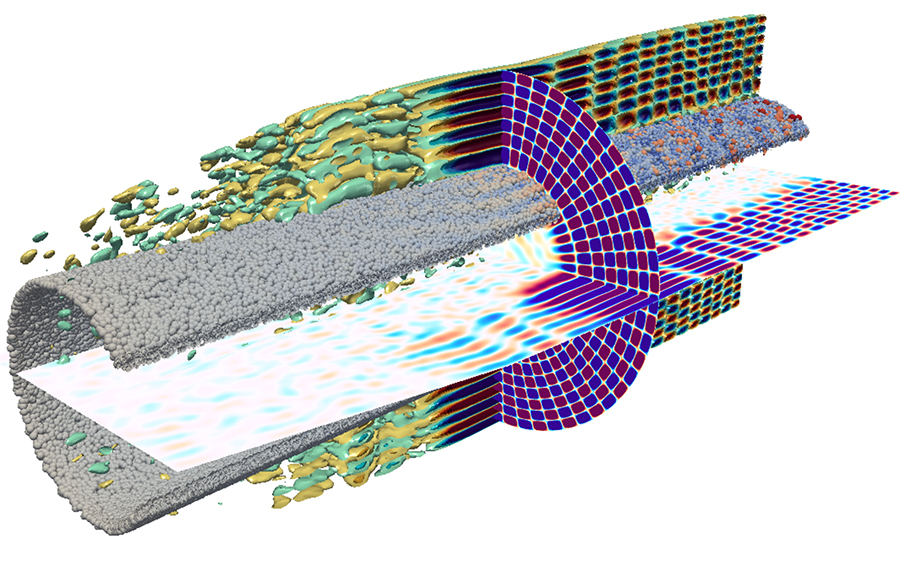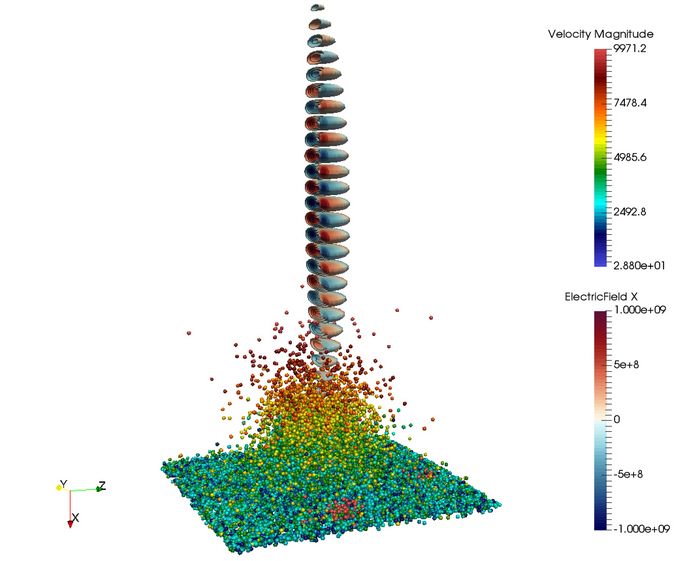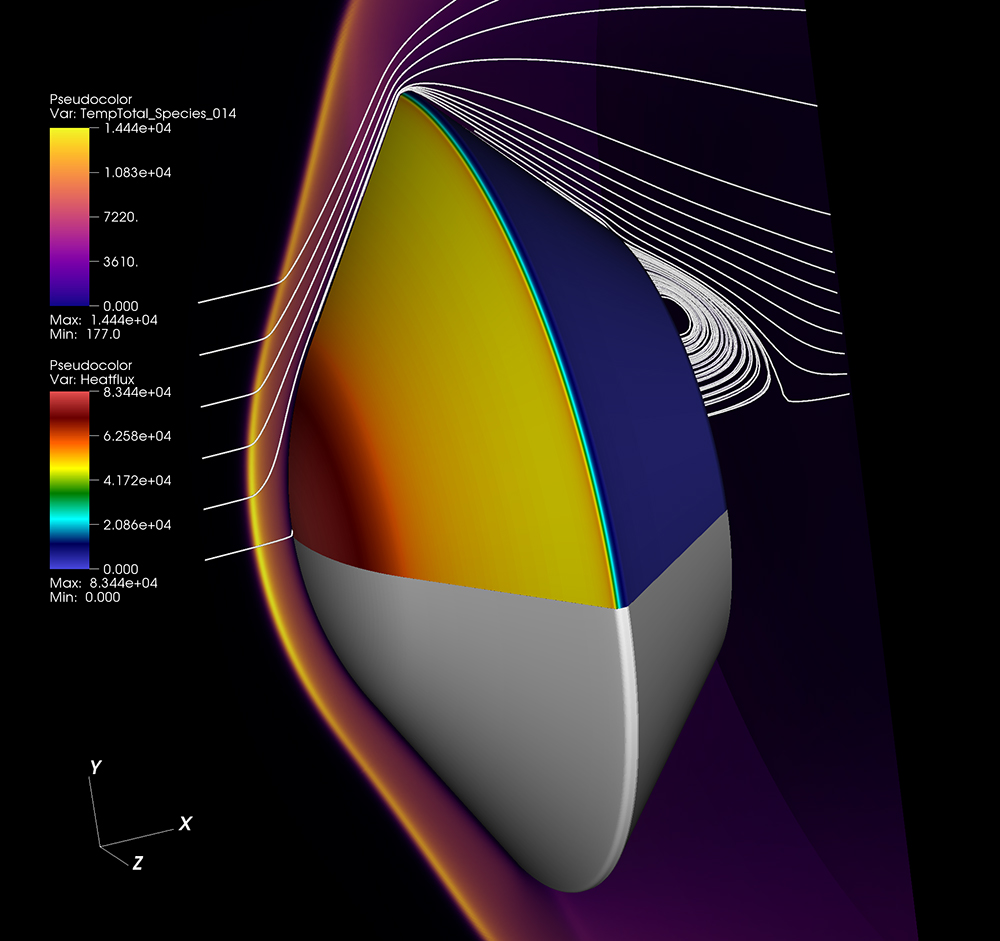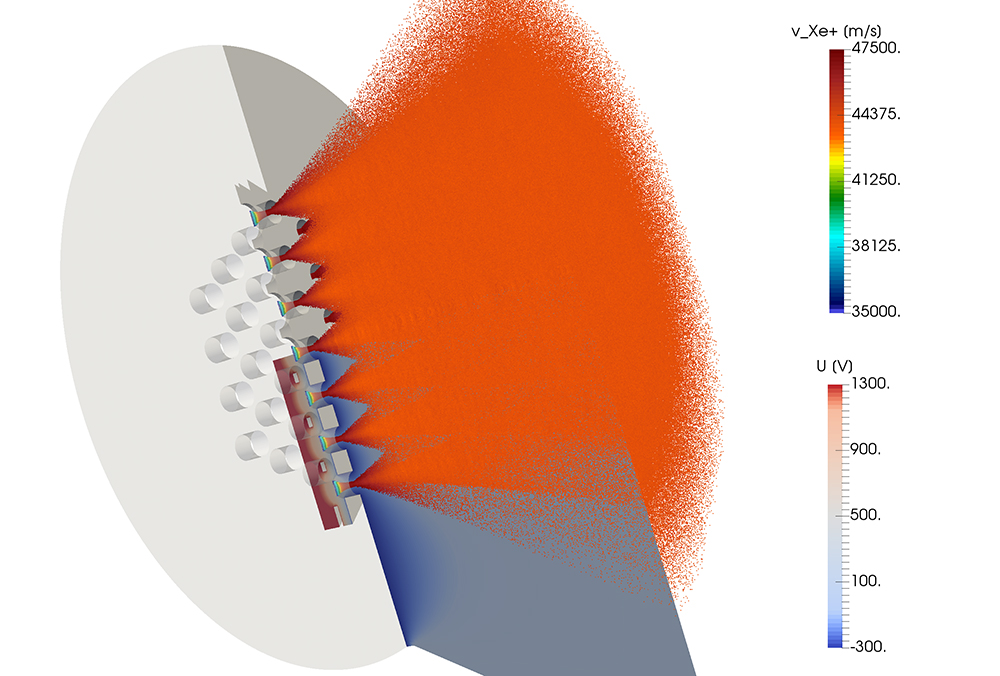ENGINEERING AND CFD
Development of a Coupled Particle-In-Cell & Direct Simulation Monte Carlo Method for the Simulation of Non-Equilibrium Plasma and Gas Flow Applications
Principal Investigator:
Dr.-Ing. Marcel Pfeiffer (IRS), Prof. Dr.-Ing. Stefanos Fasoulas, Prof. Dr. Claus-Dieter Munz (IAG)
Affiliation:
University of Stuttgart, (Germany)
Local Project ID:
IMPD
HPC Platform used:
Hazel Hen of HLRS
Date published:
For the investigation of continuum flows and plasmas, numerous methods for the solution of the Euler-, Navier-Stokes or Magnetohydrodynamic (MHD) equations exist. These systems of equations are only applicable with the assumption of continuum flows, with the Navier-Stokes equations, as opposed to the Euler equations, approximatively taking into account dissipative transport phenomena such as viscosity, mass diffusion and heat transfer. The MHD equations additionally take into account the interaction between electromagnetic fields and the charged fluid. If the deviation from the continuum is significant, the approximation of these transport phenomena is insufficient and an error is introduced. Therefore, conventional continuum methods are not suitable for the simulation of rarefied gas flows. Instead, microscopic approaches are utilized, where the flow is modelled by the movement of simulation particles. Within small time steps, these particles move through the computational domain without intermolecular interaction and collide with boundaries, where impulse and energy can be exchanged. Additionally, inter-particle collisions including possible energy relaxation as well as chemical reactions are treated statistically. Furthermore, the particles are coupled to electromagnetic fields with a self-consistent approach. This means that while particles are source terms for the electromagnetic equations, they are at the same time influenced by the resulting electromagnetic fields.
The challenges herein are multi-disciplinary problems, where fluid dynamics are combined with electromagnetic interactions as well as multi-scale problems with different orders of magnitude in the spatial and temporal resolution. Furthermore, the drawback of the higher accuracy of particle methods compared with conventional continuum methods is the higher computational effort due to large necessary particle numbers and small time steps. Therefore, these simulations are only possible using high-performance computing (HPC) systems for real applications but allow a detailed understanding of physical phenomena in the complex non-equilibrium gas and plasma regime.
The Institute of Space Systems (IRS) and the Institute of Aerodynamics and Gas Dynamics (IAG) cooperatively develop the particle simulation tool "PICLas", a flexible simulation suite for the computation of three-dimensional plasma flows. PICLas is a coupled solver, which consists of a module for Particle in Cell (PIC) and Direct Simulation Monte Carlo (DSMC). The PIC module is responsible for the collisionless electromagnetic interactions and is based on a high-order discontinuous Galerkin field solver. The PIC method is complemented by the DSMC module, which calculates the collisions and chemical reactions of the particles.
Both methods are being used in a variety of applications, where a few will be introduced in the following.
Gyrotron Oscillators for the Generation of High-Power Microwaves
Gyrotrons are vacuum tubes for the generation of electromagnetic waves in the millimetre regime that provide up to mega watts of power. Applications range from plasma diagnostics and thermonuclear fusion to X-ray production and industrial heating devices. The physical phenomenon that is exploited is the cyclotron resonance of the electrons in a hollow beam which is flowing in the centre of the device along its axis. Very hot plasmas that are necessary for thermonuclear fusion can be effectively heated by microwaves created by gyrotrons. An example of a simulation of a gyrotron developed for the experimental fusion reactor Wendelstein 7-X is shown in the figure below. Gyrotron devices can be very sensitive to misalignments of, e.g., the electron hollow beam or the external magnetic field that is supplied by superconducting magnets and can be investigated by computer simulations numerically. For future gyrotrons with increased power and efficiency, high-order modes are required. This leads to an even higher demand in computational resources, which can currently only be met by the use of super computers.

Fig 1. W7-X gyrotron showing a 140 GHz TE28,8 mode pattern of the electric field. The output power is ~1 MW. The electron hollow beam travels from left to right. In the cavity (the centre region), the microwaves are excited and travel downstream to the exit port, where they are extracted.
Copyright: IRS, Uni StuttgartLaser-Plasma Interaction
The interaction of high-energy lasers with different kinds of plasmas is a promising method for future particle accelerators that are more efficient and require much less space as compared to circular accelerators like the Large Hadron Collider (LHC) at CERN. These highly accelerated particles can be used for basic research in physics, industrial applications like surface manufacturing and cancer treatment in medicine. This simulation of the acceleration process with many complex phenomena acting simultaneously is a difficult and computationally expensive task and is used in combination with experimental investigations to broaden basic physical understanding.
The figure below shows the distribution of protons after a laser pulse has interacted with a thin slab of plasma that is composed of electrons protons and higher-charged ions. The highly-relativistic interaction between charged particles and electromagnetic waves accounts for the heavy computational resources used for simulating such processes.

Fig 2. Aluminium plasma interacting with laser pulse.
Copyright: IRS, Uni StuttgartHigh-Fidelity Numerical Simulations of Atmospheric Entry Manoeuvres
Future space exploration of Saturn’s moon Titan is of great interest to the scientific community due to the diverse organic chemistry and the possibility of liquid water beneath the planetary surface. During the deceleration of spacecraft through Titan’s thick nitrogen atmosphere, the hot gas flow is dominated by chemical reactions and non-equilibrium effects. For the design of the thermal protection system, which allows for a safe descent to the surface, numerical simulations are utilized. Sophisticated methods are required to simulate the rarefied, non-equilibrium gas flow around the spacecraft. For this purpose, the computationally demanding particle method, Direct Simulation Monte Carlo (DSMC), is utilized. The high-fidelity simulation results can be utilized to increase the confidence in the design of the spacecraft and increase the mass available for scientific instrumentation that will facilitate scientific discoveries.

Fig 3. Flow field around a spacecraft during an aero-breaking manoeuvre at Titan.
Copyright: IRS, Uni StuttgartCombined Optic Plume Simulations of Ion Propulsion Systems
Electric propulsion systems have gained in importance during the last years. The energy content of propellant presents the biggest limitation in terms of maximum achievable exhaust velocity. Additional energy can be brought by electrical means into the propellant from the outside. Therefore, higher exhaust velocities are achievable resulting in an increased propellant utilization efficiency. One example are gridded ion thrusters that use an electrostatic grid system for ion acceleration and subsequent neutralization of the plume with electrons.
The numerical simulation of ion thruster optics is one of the most common applications of particle-based methods in the field of electric propulsion. The validity of simulation results is only given as long as the system is operated far from electron back-streaming, which is one of the most dangerous failure modes of those thrusters. A fully kinetic numerical description is desirable, but for this, sophisticated approaches such as high-fidelity Particle-In-Cell (PIC) methods are necessary, capable to realistically handle the different scales of heavy ions and very low mass electrons.

Fig 4. The figure shows the simulated plume near to the grid of a miniaturized ion thruster of 4 cm diameter. The ions are extracted from the upstream plasma on the left through the, in this case, 37 grid apertures. The reference potential of 0V inside the plume and at the downstream boundary is achieved by neutralizing with electrons coming from the right hand side.
Copyright: University of StuttgartPeer-Reviewed Journal Publications:
Mirza, A., Nizenkov, P., Pfeiffer, M., and Fasoulas, S. (2017). Three-dimensional implementation of the low diffusion method for continuum flow simulations. Computer Physics Communications, In Press. doi:10.1016/j.cpc.2017.07.018
Nizenkov, P., Pfeiffer, M., Mirza, A., and Fasoulas, S. (2017). Modeling of chemical reactions between polyatomic molecules for atmospheric entry simulations with direct simulation Monte Carlo. Physics of Fluids 29(7), 077104. doi:10.1063/1.4995468 Scilight Article
Copplestone, S. M., Ortwein P., Munz C.-D. (2017). Complex-Frequency Shifted PMLs for Maxwell's Equations With Hyperbolic Divergence Cleaning and Their Application in Particle-in-Cell Codes. IEEE Transactions on Plasma Science, 45 (1), pp. 2-14. doi:10.1109/TPS.2016.2637061
Pfeiffer, M. & Gorji, M.H. (2017). Adaptive particle-cell algorithm for Fokker-Planck based rarefied gas flow simulations. Computer Physics Communications 213, 1-8. doi:10.1016/j.cpc.2016.11.003
Pfeiffer, M., Nizenkov, P., Mirza, A., and Fasoulas, S. (2016). Direct simulation Monte Carlo modeling of relaxation processes in polyatomic gases. Physics of Fluids 28(2), 027103. doi:10.1063/1.4940989
Nizenkov, P., Noeding, P., Konopka, M. and Fasoulas, S. (2016). Verification and validation of a parallel 3D direct simulation Monte Carlo solver for atmospheric entry applications. CEAS Space Journal 9(1), 127-137. doi:10.1007/s12567-016-0133-5
Pfeiffer, M., Munz, C.-D. and Fasoulas, S. (2015). Hyperbolic divergence cleaning, the electrostatic limit, and potential boundary conditions for particle-in-cell codes. Journal of Computational Physics 294, 547–561. doi:10.1016/j.jcp.2015.04.001
Pfeiffer, M., Mirza, A., Munz, C.-D. and Fasoulas, S. (2015). Two statistical particle merge and split methods for Particle-In-Cell codes. Computer Physics Communications 191, 9–24. doi:10.1016/j.cpc.2015.01.010
Munz, C.-D., Auweter-Kurtz, M., Fasoulas, S. et al. (2014). Coupled Particle-In-Cell and Direct Simulation Monte Carlo method for simulating reactive plasma flows. Comptes Rendus Mécanique 342(10-11), 662–670. doi:10.1016/j.crme.2014.07.005
Pfeiffer, M., Mirza, A. and Fasoulas, S. (2013). A grid-independent particle pairing strategy for DSMC. Journal of Computational Physics 246, 28–36. doi:10.1016/j.jcp.2013.03.018
Stindl, T., Neudorfer, J., Stock, A. et al. (2011). Comparison of coupling techniques in a high-order discontinuous Galerkin-based particle-in-cell solver. Journal of Physics D: Applied Physics 44, 194004. doi:10.1088/0022-3727/44/19/194004
Websites:
http://www.irs.uni-stuttgart.de/forschung/numerische_modellierung_und_simulation/index.en.html
https://nrg.iag.uni-stuttgart.de/
Scientific Contact:
Dr.-Ing. Marcel Pfeiffer, Prof. Dr.-Ing. Stefanos Fasoulas
Institute of Space Systems (IRS)
University of Stuttgart
Pfaffenwaldring 29, D-70569 Stuttgart, Germany
e-mail: mpfeiffer [at] irs.uni-stuttgart.de
e-mail: fasoulas [at] irs.uni-stuttgart.de
Prof. Dr. Claus-Dieter Munz
Institute of Aerodynamics and Gas Dynamics
University of Stuttgart
Pfaffenwaldring 21, D-70569 Stuttgart, Germany
e-mail: munz [at] iag.uni-stuttgart.de